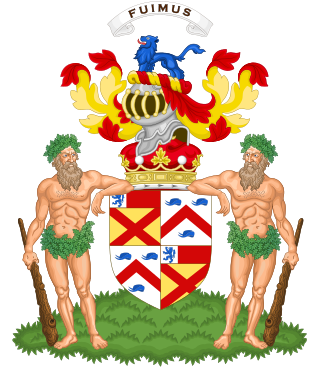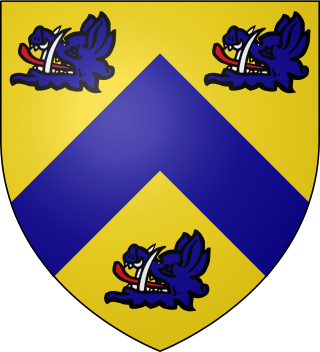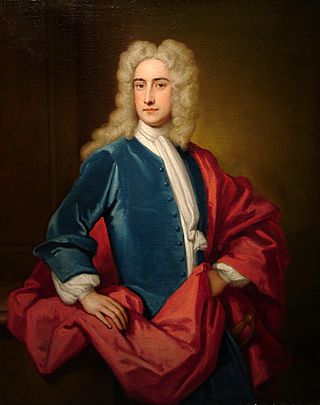
Duke of Atholl, named after Atholl in Scotland, is a title in the Peerage of Scotland held by the head of Clan Murray. It was created by Queen Anne in 1703 for John Murray, 2nd Marquess of Atholl, with a special remainder to the heir male of his father, the 1st Marquess.

Duke of Fife is a title in the Peerage of the United Kingdom that has been created twice, in both cases for the Earl of Fife. In 1889, Lord Fife married Princess Louise, the eldest daughter of Albert Edward, Prince of Wales and a granddaughter of Queen Victoria.
The Peerage of the United Kingdom is one of the five Peerages in the United Kingdom. It comprises most peerages created in the United Kingdom of Great Britain and Ireland after the Acts of Union in 1801, when it replaced the Peerage of Great Britain. New peers continued to be created in the Peerage of Ireland until 1898

Viscount Cobham is a title in the Peerage of Great Britain that was created in 1718. Owing to its special remainder, the title has passed through several families. Since 1889, it has been held by members of the Lyttelton family.

Earl of Abingdon is a title in the Peerage of England. It was created on 30 November 1682 for James Bertie, 5th Baron Norreys of Rycote. He was the eldest son of Montagu Bertie, 2nd Earl of Lindsey by his second marriage to Bridget, 4th Baroness Norreys de Rycote, and the younger half-brother of Robert Bertie, 3rd Earl of Lindsey. His mother's family descended from Sir Henry Norris, who represented Berkshire and Oxfordshire in the House of Commons and served as Ambassador to France. In 1572 he was summoned by writ to Parliament as Lord Norreys de Rycote. He was succeeded by his grandson, the second Baron. In 1621, he created Viscount Thame and Earl of Berkshire in the Peerage of England. He had no sons and on his death in 1624 the viscountcy and earldom became extinct. He was succeeded in the barony by his daughter Elizabeth, the third holder of the title. On her death, the title passed to her daughter, the aforementioned Bridget, the fourth Baroness, and second wife of the second Earl of Lindsey.

Marquess Townshend is a title in the Peerage of Great Britain held by the Townshend family of Raynham Hall in Norfolk. The title was created in 1787 for George Townshend, 4th Viscount Townshend.

Marquess of Ailesbury, in the County of Buckingham, is a title in the Peerage of the United Kingdom. It was created on 17 July 1821 for Charles Brudenell-Bruce, 2nd Earl of Ailesbury.

Earl of Cardigan is a title in the Peerage of England, currently held by the Marquesses of Ailesbury, and used as a courtesy title by the heir apparent to that Marquessate, currently Thomas Brudenell-Bruce, Earl of Cardigan, son of the 9th Marquess. The Brudenell family descends from Sir Robert Brudenell, Chief Justice of the Common Pleas from 1520 to 1530. His great-grandson, Sir Thomas Brudenell, was created a Baronet in the Baronetage of England, styled "of Deene in the County of Northampton", on 29 June 1611. On 26 February 1628, he was raised to the Peerage of England as Baron Brudenell, of Stanton Wyvill in the County of Leicester, and on 20 April 1661 he was further honoured when he was made Earl of Cardigan, also in the Peerage of England. On his death, the titles passed to his son, Robert, the 2nd Earl, and on the 2nd Earl's death to his grandson, George, the 3rd Earl, the 2nd Earl's only son, Francis, Lord Brudenell, having predeceased his father.

Earl of Dalhousie, in the County of Midlothian, is a title in the Peerage of Scotland, held by the Chief of Clan Ramsay.

Earl of Dunmore is a title in the Peerage of Scotland.

Lord Kinloss is a title in the Peerage of Scotland. It was created in 1602 for Edward Bruce, later Master of the Rolls, with remainder to his heirs and assigns whatsoever. In 1604 he was also made Lord Bruce of Kinloss, with remainder to his heirs male, and in 1608 Lord Bruce of Kinloss, with remainder to any of his heirs. He was succeeded by his son, the second Lord, who was killed in a duel in 1613.

Lord Rollo, of Duncrub in the County of Perth, is a title in the Peerage of Scotland. It was created on 10 January 1651 for Sir Andrew Rollo, with remainder to his heirs male whatsoever. His great-great-grandson, the fifth Lord, was a Brigadier-General in the Army and fought in North America during the Seven Years' War. He died without surviving male issue and was succeeded by his younger brother, the sixth Lord. His grandson, the eighth Lord, sat in the House of Lords as a Scottish representative peer from 1841 to 1846. His son, the ninth Lord, was a Scottish Representative Peer from 1847 to 1852. His son, the tenth Lord, sat in the House of Lords as a Scottish Representative Peer from 1860 to 1868. On 29 June 1869 he was created Baron Dunning, of Dunning and Pitcairns in the County of Perth, in the Peerage of the United Kingdom, with remainder to the heirs male of his body. This title gave the Lords an automatic seat in the House of Lords until 1999. As of 2017 the titles are held by the tenth Lord's great-great-grandson, the fourteenth Lord, who succeeded his father in 1997. He is the hereditary Clan Chief of Clan Rollo.

Earl of Gainsborough is a title that has been created twice, once in the Peerage of England and once in the Peerage of the United Kingdom. The first creation ended in extinction when the sixth Earl died without heirs. However, the title was revived in 1841 for a female-line relative.

Earl of Effingham, in the County of Surrey, is a title in the Peerage of the United Kingdom, created in 1837 for Kenneth Howard, 11th Baron Howard of Effingham, named after the village of Effingham, Surrey, where heads of the family owned the manor.

Viscount Charlemont is a title in the Peerage of Ireland. It was created in 1665 for William Caulfeild, 5th Baron Charlemont.

Viscount Southwell, of Castle Mattress in the County of Limerick, is a title in the Peerage of Ireland. It was created in 1776 for Thomas Southwell, 3rd Baron Southwell. The Southwell family descends from Thomas Southwell. In 1662 he was created a Baronet, of Castle Mattress in the County of Limerick, in the Baronetage of Ireland. He was succeeded by his son, the second Baronet. He represented County Limerick in the Irish Parliament. In 1717 he was created Baron Southwell, of Castle Mattress, in the County of Limerick, in the Peerage of Ireland. His grandson was the aforementioned third Baron, who was elevated to a viscountcy in 1776. Before succeeding in the barony he had represented Enniscorthy in the Irish House of Commons. His great-grandson, the fourth Viscount, served as Lord Lieutenant of County Leitrim between 1872 and 1878. As of 2019 the titles are held by his great-great-grandson, the eighth Viscount, who succeeded his father in that year.

Baron Sandys is a title that has been created three times, once in the Peerage of England, once in the Peerage of Great Britain and once in the Peerage of the United Kingdom.

Baron Brougham and Vaux, of Brougham in the County of Westmorland and of High Head Castle in the County of Cumberland, is a title in the Peerage of the United Kingdom. It was created in 1860 for Henry Brougham, 1st Baron Brougham and Vaux, a lawyer, Whig politician, and formerly Lord Chancellor, with remainder to his younger brother William Brougham. He had already been created Baron Brougham and Vaux, of Brougham in the County of Westmorland, in 1830, also in the Peerage of the United Kingdom, with normal remainder to the heirs male of his body.

George William Fox Kinnaird, 9th Lord Kinnaird, KT, PC was a Scottish Whig politician. He served as Master of the Buckhounds under Lord Melbourne from 1839 to 1841.
Lord Hamilton, Baron of Strabane, in the County of Tyrone, is a title in the Peerage of Ireland created on 8 May 1617, for James Hamilton, Master of Abercorn, eldest son of James Hamilton, 1st Earl of Abercorn, during the life of his father ; the barony had the special remainder to the heir-males of his father. He was about thirteen at the time. Both Abercorn and Paisley were in the peerage of Scotland. He inherited his father's several titles in 1618, his grandfather's title in 1621.













